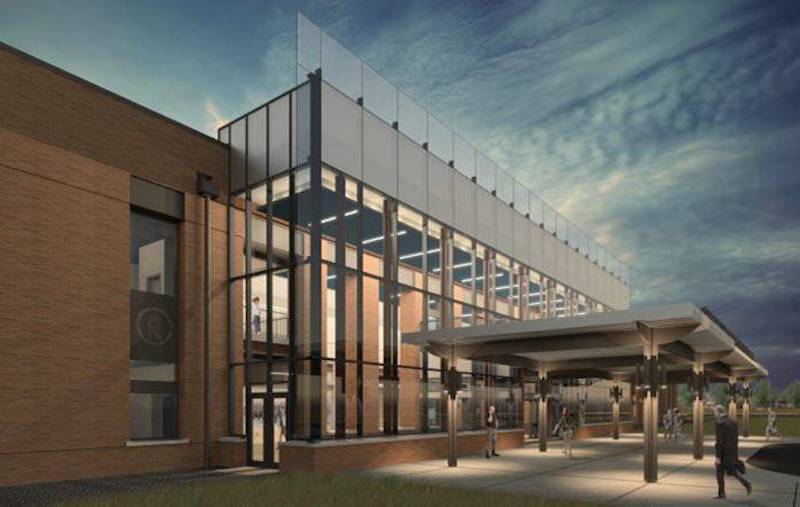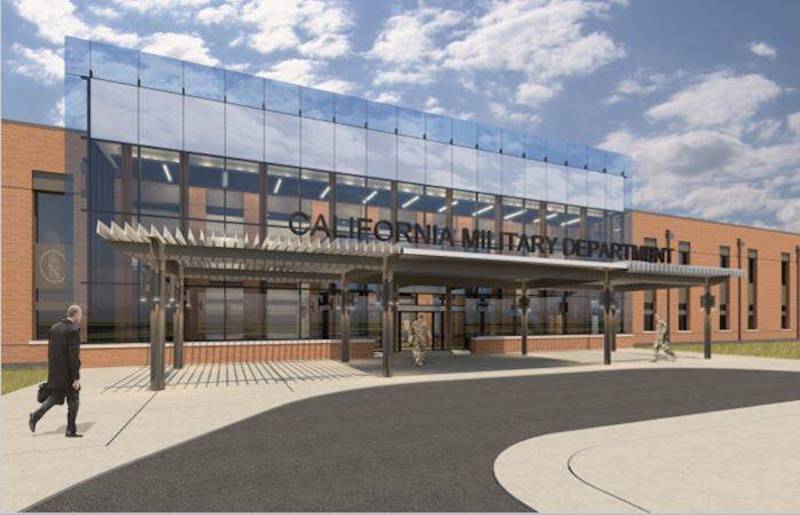The California Military Department’s (CMD) new Consolidated Headquarters Complex (CHQC) will be one of the first large scale new Zero Net Energy projects implemented by the State of California after the issuance of Gov. Jerry brown’s Executive Order B-18-12 to reduce greenhouse gas emissions and improve energy in California.
The $135 million, 285,000-sf campus will comprise multiple buildings and sit on a 31-acre site adjacent to Mather Airport. A headquarters office building, warehouse, emergency operations center, utilities building, badging center, and access control point are all included in the design.
 Rendering courtesy of Stantec.
Rendering courtesy of Stantec.
The Stantec-designed project is targeting LEED Gold certification and will include an on-site photovoltaic array that will also serve as parking shade structures. Each building on the new campus is designed with the same architectural principles to create a cohesive campus aesthetic. The buildings’ facades will feature a combination of brick veneer, metal panels, and fenestrations. Each facade is designed specifically for each building in relation to its orientation and will aid with daylight harvesting and Net Zero Energy goals.
See Also: Spector Group unveils new law enforcement center for Nassau County
Stantec is providing architecture, interior design, ZNE consulting, sustainability, energy modeling, landscape design, acoustics, lighting, security, and information and communications technology design services. Walsh Construction Company II is building the project. The CHQC is slated to open in 2020.
Related Stories
| Jul 18, 2014
Top Architecture Firms [2014 Giants 300 Report]
Gensler, Perkins+Will, NBBJ top Building Design+Construction's 2014 ranking of the largest architecture firms in the United States.
| Jul 18, 2014
2014 Giants 300 Report
Building Design+Construction magazine's annual ranking the nation's largest architecture, engineering, and construction firms in the U.S.
| Jul 7, 2014
7 emerging design trends in brick buildings
From wild architectural shapes to unique color blends and pattern arrangements, these projects demonstrate the design possibilities of brick.
| Jul 2, 2014
Emerging trends in commercial flooring
Rectangular tiles, digital graphic applications, the resurgence of terrazzo, and product transparency headline today’s commercial flooring trends.
| Jun 30, 2014
Research finds continued growth of design-build throughout United States
New research findings indicate that for the first time more than half of projects above $10 million are being completed through design-build project delivery.
| Jun 18, 2014
Arup uses 3D printing to fabricate one-of-a-kind structural steel components
The firm's research shows that 3D printing has the potential to reduce costs, cut waste, and slash the carbon footprint of the construction sector.
| Jun 12, 2014
Austrian university develops 'inflatable' concrete dome method
Constructing a concrete dome is a costly process, but this may change soon. A team from the Vienna University of Technology has developed a method that allows concrete domes to form with the use of air and steel cables instead of expensive, timber supporting structures.
| Jun 9, 2014
Green Building Initiative launches Green Globes for Sustainable Interiors program
The new program focuses exclusively on the sustainable design and construction of interior spaces in nonresidential buildings and can be pursued by both building owners and individual lessees of commercial spaces.
| May 29, 2014
7 cost-effective ways to make U.S. infrastructure more resilient
Moving critical elements to higher ground and designing for longer lifespans are just some of the ways cities and governments can make infrastructure more resilient to natural disasters and climate change, writes Richard Cavallaro, President of Skanska USA Civil.
| May 20, 2014
Kinetic Architecture: New book explores innovations in active façades
The book, co-authored by Arup's Russell Fortmeyer, illustrates the various ways architects, consultants, and engineers approach energy and comfort by manipulating air, water, and light through the layers of passive and active building envelope systems.
















